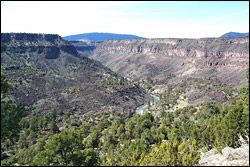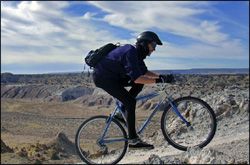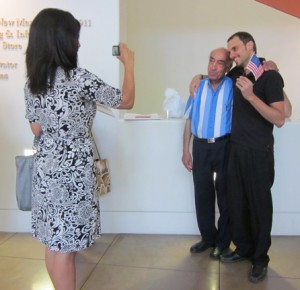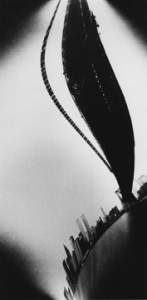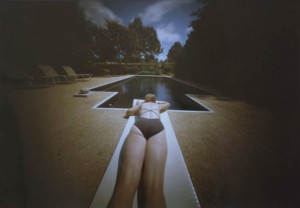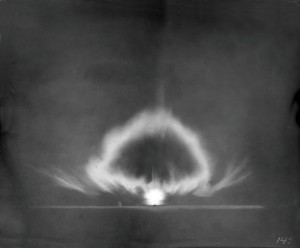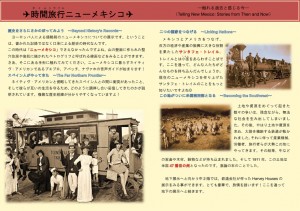For his part in the New Mexico History Museum’s Centennial Letters Project, John E. Gumert, a retired BLM worker now living in Ingram, Texas, sent us the most delightful remembrance of communities that were changed by an early 1960s idea from a president who didn’t live to see the outcome. We like it so much that we’re sharing it in full, illustrated by images from the Bureau of Land Management’s website. (There’s still time to send us your remembrances for the project–describe your life in this, the 100th year of New Mexico statehood, or something about your life or your family’s that fills in the gaps for future historians. Send the letters to Centennial Letters Project, New Mexico History Museum, 113 Lincoln Avenue, Santa Fe, NM, 87501.)
A Shovel-Ready Project
By John E. Gumert
When I hear the term “shovel-ready projects” or references to employment with funding by the 2009 stimulus bill, I flash back in time to a real “shovel-ready project,” when I worked for a federal agency in New Mexico, in 1962.
It was Thursday, November 1, 1962, Albuquerque. Six of us U.S. Bureau of Land Management employees, about half the staff, were eating lunch, when we had a telephone call from state headquarters, Santa Fe. We learned that President John F. Kennedy had just authorized $400 million, for a nationwide accelerated public works program (AWP). We had our own wish list, had talked and planned, but with little funding, we had not been able to get this work done.
Our state office did not know how much funding we’d get, just that President Kennedy wanted projects started immediately, with photographs of workers on his desk in Washington, D.C., on Monday, November 5, when he would officially announce the program’s beginning.
Our orders were, “Don’t worry about purchasing or hiring rules. This is immediate.”
In the BLM office, I was range manager.
Our responsibilities were for one-and-a-quarter million acres of public lands, north of Albuquerque to the Colorado border. The late Claude Martin was district manager.
I’m left to tell the story. That afternoon, with enthusiasm, we discussed possible projects for northern New Mexico: range improvements, especially in the arid Rio Puerco watershed; forest work, thinning and reseeding fire breaks; recreation development, not even a program in 1962.
We contacted the New Mexico State Park Division, which had a plan on its shelf to develop recreation facilities along the Rio Grande, where the river ran swiftly through a deep canyon. Yes! We were definitely shovel-ready. This became our priority project for the BLM in New Mexico, with NM Parks providing its plan and a staff member.
By 4 pm that day, I was driving a BLM pickup to Taos, with orders to buy wheelbarrows, shovels, picks, hand tools for 100 people. Occasionally, I heard the bulky mobile radio in the pickup crackle, with voices coming through static to tell me that the state employment office was announcing hiring processes. They would open a hiring hall in Taos Plaza at 8 am, Friday, just hours away.
From Taos’s two hardware stores, I bought with government purchase orders the stores’ entire stocks of wheelbarrows, shovels, picks, canteens, first-aid kits, heavy gloves. I stayed in Taos, to watch and take photos, with a 4×5 Speed Graphic camera, of the hiring. A BLM team arrived. The late Walt Stone was named project director. We decided to set up a second project, forest improvement, near Peñasco, NM, with Jack Dossett in charge. He’d been pushing for needed work there.
On Saturday, November 3, I guided a school bus filled with our first workers to the Rio Grande site. I knew of an old sheep trail down from the mesa to the river. This made sense as a route for a hiking trail. It’s called The Chiflo Trail, and it is about 2,560 feet in length, with an elevation drop of 320 feet.
The late Les Lawrence, a BLM employee who had worked with the Civilian Conservation Corps in the late 1930s, came out to help survey and run levels to meet trail standards.
On my mind was the order, “Photos! President Kennedy wants photos by Monday!” This was pre-computer days. I knew telephone, telegraph, teletype as modern communication. I loaded film packs into that Speed Graphic. I tried to become camera-ready. The BLM public affairs officer, Doyle Kline, came to the site. He took more photos showing shovel-ready, shovels working, magnificent scenery.
Late Saturday evening, I drove from the site, nearly 200 miles south to the Albuquerque airport, carrying a bag of undeveloped film. I hurried through the airport building (no security) to get the bag onto a 9:30 pm flight. In Washington, D.C., a BLM employee met that plane, had the film developed. Photos of the workers at our Rio Grande project were on President Kennedy’s desk, Monday morning, on time.
At the height of this accelerated works program, about 300 workers were employed in the Albuquerque district, plus several contractors with heavy equipment. Besides the Rio Grande and Peñasco projects, we had funding for range improvement in the Rio Puerco and other sites. For recreation areas, this was the beginning—openings to the public and later designation of the Rio Grande as a Wild and Scenic River.
We discovered projects that we had considered, had hoped for, that were finally possible, because we were shovel-ready. We cooperated with other agencies, and found people who were motivated to work. One of my most interesting times was going north to Fort Carson, Colorado, with BLM friend Jerry Kendrick, to pick up eight surplus three-quarter-ton GI trucks, World War II vintage, loaded with hand tools. We put those to good use in northern New Mexico.
On April 16, 1963, President Kennedy recognized our programs’ success. He asked Congress for an additional $500 million. Congress denied more funding. The work had to end.
On November 22, 1963, Jack Dossett and I were in Peñasco, passing out final checks to about 30 workers. We could see how the income had made many changes, not just in our projects, but also in the lives of hundreds of people who had been employed. Throughout the area, we saw sparkling new tin roofs on adobe houses, new pickup trucks, heard good news about local economies.
The small black-and-white TV in the café where we sat with workers sputtered out a bulletin, bleak news from Dallas, Texas. As we drove back toward Albuquerque, our BLM radio crackled to confirm our nation’s loss of President Kennedy.
Today, I can stand on the rim of the Rio Grande and look out at what was once a sheep trail, and now is a small part of a well-used recreation area. I can see visitors aim digital cameras to send photos around the world, immediately. I can hear them describe, on cell phones, what they see, what their plans are. I can watch them explore this place, their own, their public lands.
I want to remind them. “First comes the dream.”
And to each, I want to shout, “Are you shovel ready?”

